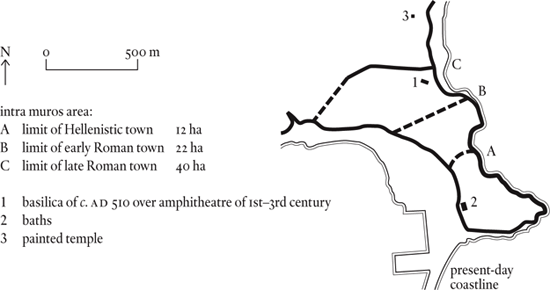
Present-day Constanţa, Romania
Roman Constantia; provincial capital of Moesia Inferior and subsequently of Scythia
Tomis, on the Black Sea coast a bit to the south of the Danube delta, was founded by Greeks from Miletus at the beginning of the sixth century BC. Like many Greek colonies of the time, it was situated on a small promontory, and the area covered by the original settlement was tiny, a matter of a few hectares. It had grown to something like twenty hectares by the time it passed under Roman control in the first century BC, but that still left it a small place, situated in inhospitable country at the edge of the classical world. That is doubtlessly why Augustus chose it as a suitable place of exile for the poet Ovid, who had offended him in some now-forgotten way. Ovid passed the last eight years of his life there (AD 9–17), bewailing his fate in numerous, self-pitying verses. Tomis’ Greek inhabitants, he had to admit, were kindly enough, but the climate was loathsome and he was constantly alarmed by the uncouth Getes and Sarmatians who raided the city’s territory and shot arrows over its walls. And it must have seemed a dismal place to one with fond memories of the fleshpots of ROME.

Tomis prospered under Roman rule. When the province of Moesia was split into two in AD 82, it was made the capital of Moesia Inferior. It was also placed at the head of the Pontic Federation, an association of Greek cities on the west side of the Black Sea, some of them beyond the Roman frontier. A new wall ascribed to the late second century took the intramural area up to about forty hectares.
Decline set in during the early fourth century when the town’s area of responsibility was restricted to the terminal stretch of the Danube, the province of Scythia in the new order of things. Not long after, it was renamed Constantia after Constantine the Great, who presumably conferred some marks of favour on the city. It survived the Gothic and Hunnic invasions only to be swept away by the Slav outpouring of the late sixth and early seventh century. No more than a village when it was taken over by the nascent Romanian state in 1878, it is now the country’s largest port with a population of 350,000. This makes the investigation of the classical town very difficult, and the archaeologists’ ideas on the way the city developed, although doubtless correct in outline, lack the detail needed to bring its history to life.